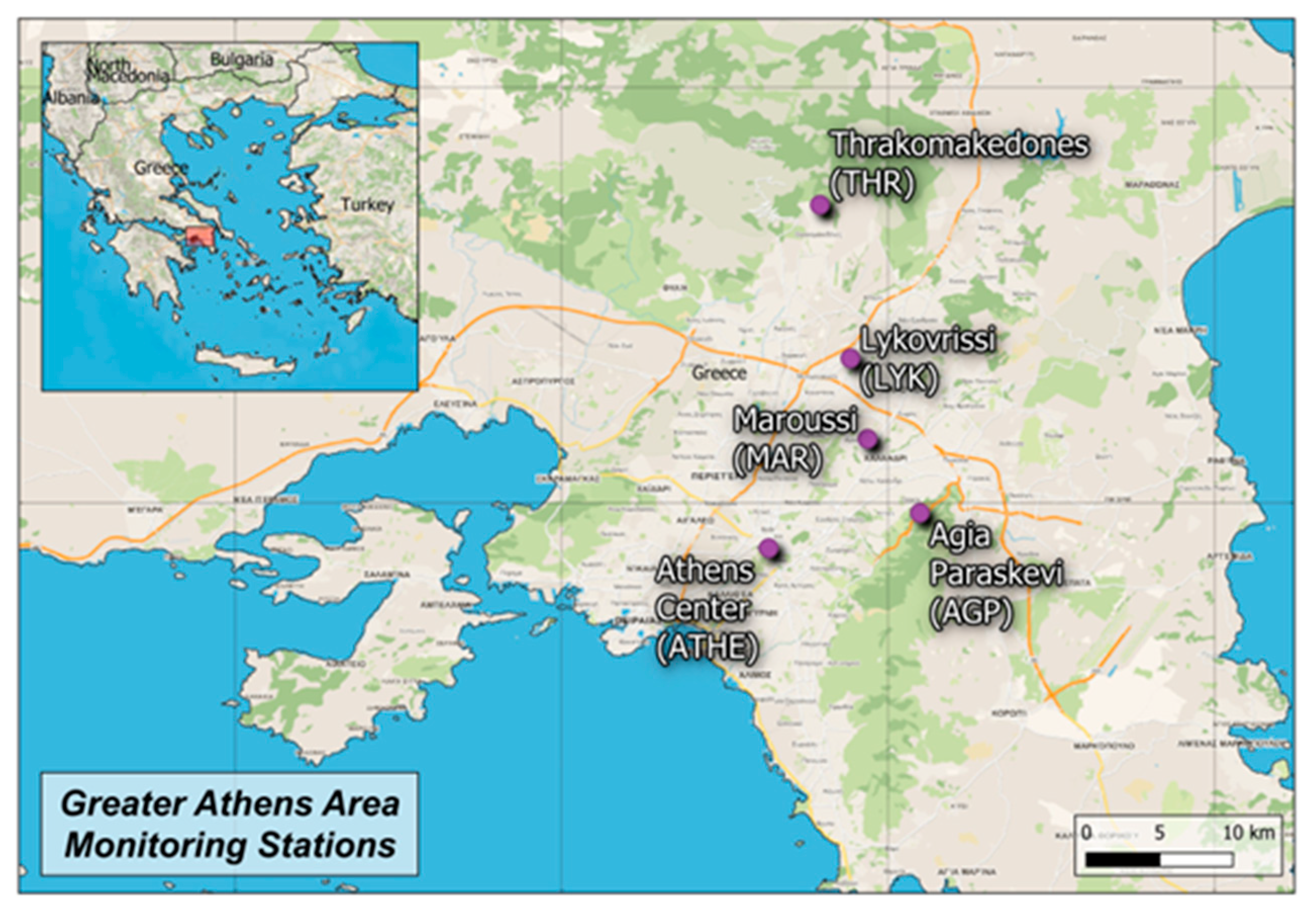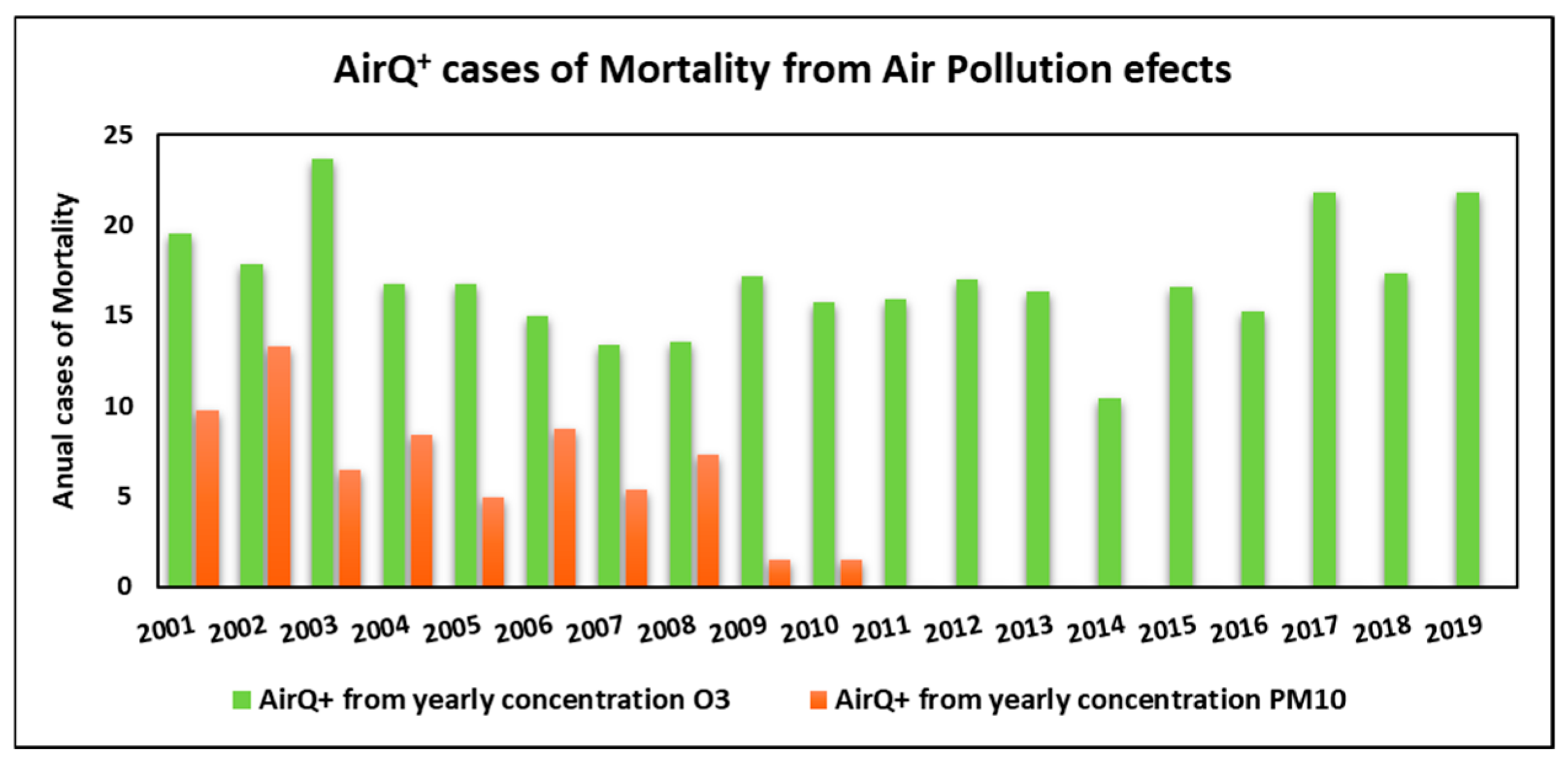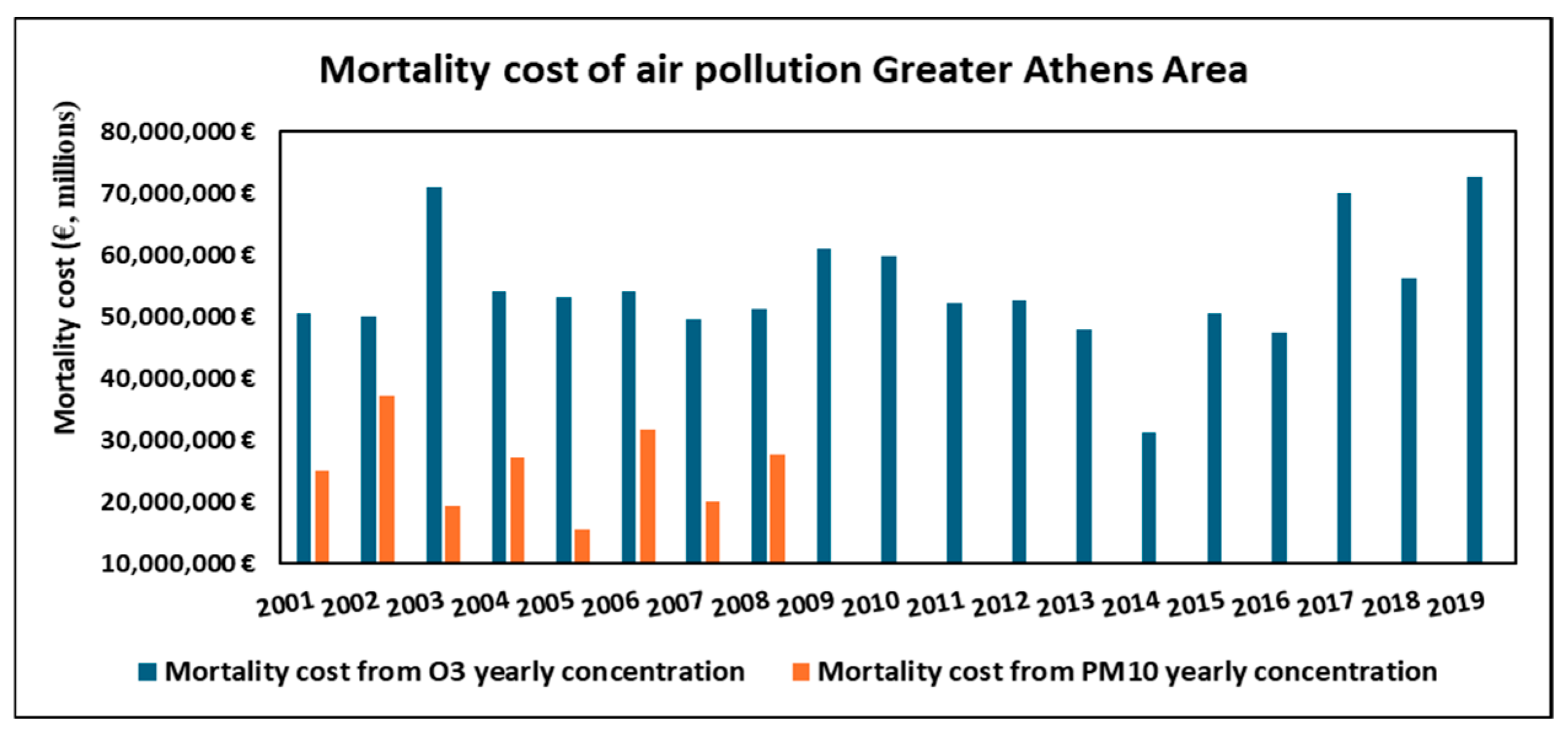Economic Costs Associated with the Adverse Health Effects of PM10 and O3 Health over the Greater Athens Area, Greece, for the Period 2001–2019 †
Abstract
1. Introduction
2. Materials and Methods
2.1. Data Sources
2.2. Estimating Mortality Caused by Air Pollution
2.3. VSL-Economic Burden Approach
3. Results and Discussion
3.1. The Temporal Variation of PM10 and O3 Concentrations
3.2. Air Pollution Effects: AirQ+ Mortality Cases and Economic Burden
4. Conclusions
Author Contributions
Funding
Institutional Review Board Statement
Informed Consent Statement
Data Availability Statement
Conflicts of Interest
References
- World Health Organization. WHO Global Air Quality Guidelines: Particulate Matter (PM2.5 and PM10), Ozone, Nitrogen Dioxide, Sulfur Dioxide and Carbon Monoxide; World Health Organization: Geneva, Switzerland, 2021; ISBN 978-92-4-003422-8. [Google Scholar]
- Health Metrics. Evaluation (IHME) GBD Results Tool: GBD 2019 Codebook and Data Guide. 29 June 2022. Available online: http://www.healthdata.org/about/terms-and-conditions (accessed on 20 September 2024).
- Viscusi, W.K.; Masterman, C.J. Income Elasticities and Global Values of a Statistical Life. J. Benefit Cost Anal. 2017, 8, 226–250. [Google Scholar] [CrossRef]
- World Bank; Institute for Health Metrics and Evaluation. The Cost of Air Pollution: Strengthening the Economic Case for Action; The World Bank: Washington, WA, USA, 2016. [Google Scholar]
- Murray, C.J.L. The Global Burden of Disease Study at 30 Years. Nat. Med. 2022, 28, 2019–2026. [Google Scholar] [CrossRef] [PubMed]
- Psistaki, K.; Petrou, I.; Paschalidou, A.K.; Kassomenos, P. Temporal and Spatial Characteristics of the Economic Burden Related to Long-Term PM2.5 and O3 Exposure in Greece for the Period 2004–2019. Environ. Sci. Proc. 2023, 26, 14. [Google Scholar] [CrossRef]
- HMEE Hellenic Ministry of Environment and Energy. Available online: https://ypen.gov.gr/ (accessed on 30 April 2021).
- HSA Hellenic Statistical Authority. Available online: https://www.statistics.gr/en/home/ (accessed on 20 June 2021).
- Oliveri Conti, G.; Heibati, B.; Kloog, I.; Fiore, M.; Ferrante, M. A Review of AirQ Models and Their Applications for Forecasting the Air Pollution Health Outcomes. Environ. Sci. Pollut. Res. 2017, 24, 6426–6445. [Google Scholar] [CrossRef] [PubMed]
- World Health Organization. Tools for Health Impact Assessment of Air Quality: AirQ+ Software. Available online: https://www.who.int/europe/tools-and-toolkits/airq---software-tool-for-health-risk-assessment-of-air-pollution (accessed on 20 September 2024).
- Petrou, I.; Psistaki, K.; Kassomenos, P.A.; Dokas, I.M.; Paschalidou, A.K. Studying the Economic Burden of Premature Mortality Related to PM2.5 and O3 Exposure in Greece between 2004 and 2019. Atmos. Pollut. Res. 2024, 15, 101978. [Google Scholar] [CrossRef]



| Aristotelous | Athinas | Agia Paraskevi | Maroussi | Thrakomakedones | Lykovrissi | |
|---|---|---|---|---|---|---|
| Abbreviation | ARI | ATH | AGP | MAR | THR | LYK |
| Area Size Km2 | 39 | 39 | 8 | 13 | 4 | 4 |
| Longitude | 23.727617 | 23.726845 | 23.819421 | 23.787372 | 23.758195 | 23.788986 |
| Latitude | 37.988066 | 37.978204 | 37.995110 | 38.030837 | 38.143521 | 38.067793 |
| Characterization | UT | UT | SB | UB | SB | SB |
| Population (People) | 664,000 | 664,000 | 60,000 | 73,000 | 6200 | 10,000 |
| O3 Data Completeness | n/a | 89.4% | 94.8% | 91.3% | 87.2% | 95.9% |
| Pm10 Data Completeness | 87.10% | n/a | 90.02% | 81.20% | 83.36% | 90.21% |
Disclaimer/Publisher’s Note: The statements, opinions and data contained in all publications are solely those of the individual author(s) and contributor(s) and not of MDPI and/or the editor(s). MDPI and/or the editor(s) disclaim responsibility for any injury to people or property resulting from any ideas, methods, instructions or products referred to in the content. |
© 2025 by the authors. Licensee MDPI, Basel, Switzerland. This article is an open access article distributed under the terms and conditions of the Creative Commons Attribution (CC BY) license (https://creativecommons.org/licenses/by/4.0/).
Share and Cite
Ntourou, K.; Fameli, K.-M.; Tsitsis, C.; Papachristos, T.; Moustris, K.; Manousakis, N.M. Economic Costs Associated with the Adverse Health Effects of PM10 and O3 Health over the Greater Athens Area, Greece, for the Period 2001–2019. Environ. Earth Sci. Proc. 2025, 35, 24. https://doi.org/10.3390/eesp2025035024
Ntourou K, Fameli K-M, Tsitsis C, Papachristos T, Moustris K, Manousakis NM. Economic Costs Associated with the Adverse Health Effects of PM10 and O3 Health over the Greater Athens Area, Greece, for the Period 2001–2019. Environmental and Earth Sciences Proceedings. 2025; 35(1):24. https://doi.org/10.3390/eesp2025035024
Chicago/Turabian StyleNtourou, Kleopatra, Kyriaki-Maria Fameli, Christos Tsitsis, Theodoros Papachristos, Konstantinos Moustris, and Nikolaos M. Manousakis. 2025. "Economic Costs Associated with the Adverse Health Effects of PM10 and O3 Health over the Greater Athens Area, Greece, for the Period 2001–2019" Environmental and Earth Sciences Proceedings 35, no. 1: 24. https://doi.org/10.3390/eesp2025035024
APA StyleNtourou, K., Fameli, K.-M., Tsitsis, C., Papachristos, T., Moustris, K., & Manousakis, N. M. (2025). Economic Costs Associated with the Adverse Health Effects of PM10 and O3 Health over the Greater Athens Area, Greece, for the Period 2001–2019. Environmental and Earth Sciences Proceedings, 35(1), 24. https://doi.org/10.3390/eesp2025035024









